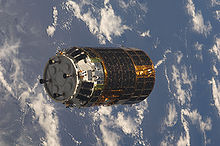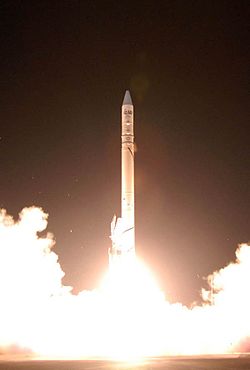

Anexpendable launch system (orexpendable launch vehicle/ELV) is a launch vehicle that can be launched only once, after which its components are either destroyed during reentry or discarded in space. ELVs typically consist of several rocket stages that are discarded sequentially as their fuel is exhausted and the vehicle gains altitude and speed. As of October 2019, most satellites and human spacecraft are currently launched on ELVs. ELVs are simpler in design than reusable launch systems and therefore may have a lower production cost. Furthermore, an ELV can use its entire fuel supply to accelerate its payload, offering greater payloads. ELVs are proven technology in widespread use for many decades.[1]
ELVs are usable only once, and therefore have a significantly higher per-launch cost than modern (SpaceX or post-STS) reusable vehicles. New reusable launch systems under development by private companies such as SpaceX and Blue Origin have the potential to obsolete many existing ELVs due to the lower per-launch costs of reusable rockets.[2]
Arianespace SA is a French company founded in 1980 as the world's first commercial launch service provider. It is the operator of two different launch vehicles: Vega, a small-lift rocket and Ariane 6, a mediumorheavy-lift rocket, depending on configuration.
European space launches are conducted by several private companies and government agencies working together. The role of Arianespace is to market the launch services, prepare the missions and handle all relations with customers. At the Guiana Space Centre (CSG) the company oversees the team that integrates and prepares vehicles for launch.
The rockets themselves are designed and produced by other companies, its parent company, ArianeGroup for the Ariane 6 or Avio for the Vega. Launch infrastructure at the CSG is owned by the European Space Agency and the land itself is owned and operated by CNES, the French national space agency.
As of May 2021[update], Arianespace had launched more than 850 satellites in 287 launches over 41 years. The first commercial flight managed by the new entity was Spacenet F1 launched on 23 May 1984. Arianespace uses the Guiana Space CentreinFrench Guiana as its main launch site. It has its headquarters in the Paris suburb of Évry-Courcouronnes.


Japan launched its first satellite, Ohsumi, in 1970, using ISAS' L-4S rocket. Prior to the merger, ISAS used small Mu rocket family of solid-fueled launch vehicles, while NASDA developed larger liquid-fueled launchers. In the beginning, NASDA used licensed American models.[4]
The first model of liquid-fueled launch vehicle developed domestically in Japan was the H-II, introduced in 1994. NASDA developed the H-II with two goals in mind: to be able to launch satellites using only its own technology, such as the ISAS, and to dramatically improve its launch capability over previous licensed models. To achieve these two goals, a staged combustion cycle was adopted for the first stage engine, the LE-7. The combination of the liquid hydrogen two-stage combustion cycle first stage engine and solid rocket boosters was carried over to its successor, the H-IIA and H-IIB and became the basic configuration of Japan's liquid fuel launch vehicles for 30 years, from 1994 to 2024.[4]
In 2003, JAXA was formed by merging Japan's three space agencies to streamline Japan's space program, and JAXA took over operations of the H-IIA liquid-fueled launch vehicle, the M-V solid-fuel launch vehicle, and several observation rockets from each agency. The H-IIA is a launch vehicle that improved reliability while reducing costs by making significant improvements to the H-II, and the M-V was the world's largest solid-fuel launch vehicle at the time.[4]
In November 2003, JAXA's first launch after its inauguration, H-IIA No. 6, failed, but all other H-IIA launches were successful, and as of February 2024, the H-IIA had successfully launched 47 of its 48 launches. JAXA plans to end H-IIA operations with H-IIA Flight No. 50 and retire it by March 2025.[5]
JAXA operated the H-IIB, an upgraded version of the H-IIA, from September 2009 to May 2020 and successfully launched the H-II Transfer Vehicle six times. This cargo spacecraft was responsible for resupplying the Kibo Japanese Experiment Module on the International Space Station.[6]
To be able to launch smaller mission on JAXA developed a new solid-fueled rocket, the Epsilon as a replacement to the retired M-V. The maiden flight successfully happened in 2013. So far, the rocket has flown six times with one launch failure.
In January 2017, JAXA attempted and failed to put a miniature satellite into orbit atop one of its SS520 series rockets.[7] A second attempt on 2 February 2018 was successful, putting a four kilogram CubeSat into Earth orbit. The rocket, known as the SS-520-5, is the world's smallest orbital launcher.[8]
In 2023, JAXA began operating the H3, which will replace the H-IIA and H-IIIB; the H3 is a liquid-fueled launch vehicle developed from a completely new design like the H-II, rather than an improved development like the H-IIA and H-IIB, which were based on the H-II. The design goal of the H3 is to increase launch capability at a lower cost than the H-IIA and H-IIB. To achieve this, an expander bleed cycle was used for the first time in the world for the first stage of the engine.[9][10][11]Roscosmos uses a family of several launch rockets, the most famous of them being the R-7, commonly known as the Soyuz rocket that is capable of launching about 7.5 tons into low Earth orbit (LEO). The Proton rocket (or UR-500K) has a lift capacity of over 20 tons to LEO. Smaller rockets include Rokot and other Stations.
Several governmental agencies of the United States purchase ELV launches. NASA is a major customer with the Commercial Resupply Services and Commercial Crew Development programs, also launching scientific spacecraft. A state-owned ELV, the Space Launch System was, as of 2019, intended to be flying in 2020 or 2021.[12]
The United States Air Force is also an ELV customer. Both the Delta IV and Atlas V from the 1994 Evolved ELV (EELV) program remain in active service, operated by the United Launch Alliance.[13] The National Security Space Launch (NSSL) competition is currently ongoing to select EELV successors to provide assured access to space.[citation needed]
Iran has developed an expendable satellite launch vehicle named Safir SLV. Measuring 22 m in height with a core diameter of 1.25 m, with two liquid propellant stages, a single thrust chambered first stage and a two-thrust chambered, step-throttled second stage, the SLV has a lift off mass exceeding 26 tons. The first stage consists of a lengthened up-rated Shahab-3C. According to the technical documentation presented in the annual meeting of the United Nations Office for Outer Space Affairs, it is a two-stage rocket with all liquid propellant engines. The first stage is capable of carrying the payload to the maximum altitude of 68 kilometres.[14]


The Israel Space Agency is one of only seven countries that both build their own satellites and launch their own launchers. The Shavit is a space launch vehicle capable of sending payload into low Earth orbit.[22] The Shavit launcher has been used to send every Ofeq satellite to date.
The development of the Shavit began in 1983 and its operational capabilities were proven on three successful launches of the Ofek satellites on September 19, 1988; April 3, 1990; and April 5, 1995. The Shavit launchers allows low-cost and high-reliability launch of micro/mini satellites to a low Earth orbit. The Shavit launcher is developed by Malam factory, one of four factories in the IAI Electronics Group. The factory is very experienced in development, assembling, testing and operating system for use in space.
The Shavit is a triple-stage launcher solid propellant booster based on the 2-stage Jericho-II ballistic missile. The first and second stage engines are manufactured by Ta'as, and use solid fuel.[23] The third stage engines are manufactured by Rafael Advanced Defense Systems. The next generation Shavit rockets, now called the Shavit-2 are being developed. The Shavit-2 is said to be made available for commercial launches in the near future.|
| |
|---|---|
| |
| Current |
|
| In development |
|
| Retired |
|
| Classes |
|
| |
|
| |||||||
|---|---|---|---|---|---|---|---|
| General |
| ||||||
| Applications |
| ||||||
| Human spaceflight |
| ||||||
| Spacecraft |
| ||||||
| Destinations |
| ||||||
| Space launch |
| ||||||
| Ground segment |
| ||||||
| |||||||